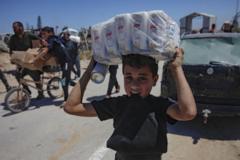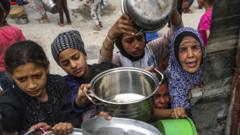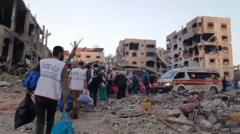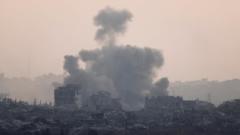In Gaza, security has deteriorated dramatically as residents face a dire food crisis, resulting in chaos and violence at distribution centers. Clashes with police and military actions have exacerbated the humanitarian situation, showcasing the tension between conflicting narratives from local authorities and Israel regarding the aid distribution challenges.
Chaos Erupts in Gaza as Desperation for Food Leads to Violence

Chaos Erupts in Gaza as Desperation for Food Leads to Violence
Amid prolonged conflict and an Israeli blockade, a surge in lawlessness grips Gaza as residents clash for scarce food supplies, leaving many dead and wounded.
In recent days, a breakdown of order has unfolded in Gaza, as desperate efforts by residents to secure food supplies take a violent turn. Compounding the existing humanitarian crisis, the Israeli blockade and ongoing military operations have left many Palestinians struggling to find basic necessities amid reported chaos and looting in northern Gaza.
The interior ministry of Hamas stated that seven police officers were killed during an Israeli airstrike while they attempted to restore order in a market in Gaza City. The Israeli military did not comment on this specific incident but noted that it targeted “dozens of terror targets” across Gaza over the past day. Palestinian medics reported that at least 44 individuals were killed in various locations throughout the territory on that Thursday alone, contributing to a mounting toll of casualties.
The situation escalated dramatically at a World Food Programme (WFP) warehouse in Deir al-Balah, where chaotic scenes unfolded as thousands attempted to break in for supplies. Reports indicated that at least two fatalities occurred due to gunfire, though the source of the shots remains unclear. A senior UN official described scenes of overwhelming crowds at distribution centers, with reports of dozens injured as they surged for aid, despite Israeli soldiers attempting to manage the situation with warning shots.
Eyewitness accounts reveal a stark picture of desperation as thousands of Palestinians gathered outside the Gaza Humanitarian Foundation (GHF) distribution site in Rafah. In response to the growing agitation, Israeli troops warned crowds, but tensions ultimately peaked when a mob breached the gates. The urgent scramble for limited food packages left many, particularly the elderly and women, feeling marginalized and humiliated.
With aid distribution severely lacking, frustrations continue to mount. One man lamented that he had returned empty-handed despite having needs to feed his family. The GHF has claimed to have distributed nearly 17,300 food boxes while refuting reports of any excess violence during the process, attributing concerns to logistical difficulties rather than operational failure.
The impediments to aid come amid a total Israeli blockade that reinstated restrictions on humanitarian supplies after a military offensive launched against Hamas on March 2. International calls for intervention and humanitarian support grow as civilian casualties rise and conditions worsen. Critiques have emerged from various bodies regarding Israel’s military actions, with the European Union condemning strikes exceeding what it deems necessary.
As tensions rise and the humanitarian crisis deepens, families of hostages, currently held by Hamas, are urging for renewed ceasefire negotiations amid fears of escalating violence. However, ongoing conflict and distrust complicate the path toward a sustainable resolution, leaving millions in Gaza strained under stark conditions.
With the situation continually evolving, the complex interplay of local governance, military strategy, and humanitarian pressure will play critical roles in shaping the future of both the Gaza Strip and its beleaguered populace.





















